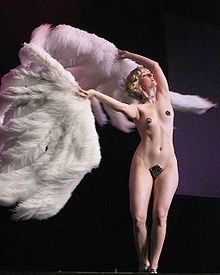New burlesque
The New Burlesque (also Neo-Burlesque ) is an independent form of erotic dance in which women appear in a humorous and imaginative way. It is primarily used for non-erotic entertainment and less for erotic animation.
Emergence
The New Burlesque is a revival of the theater form burlesque that was widespread in the USA in the 1930s . (The term burlesque is borrowed from the Italian theater of the 16th century and stands for an exaggerated and caricature representation of reality.) The new burlesque is primarily intended for entertainment and amusement, less for erotic animation, and does not claim to be moral or ethical To convey values.
Burlesque only experienced its renaissance in the 1990s as Neo-Burlesque or New Burlesque in New York through Ami Goodheart's revue "Dutch Weismanns' Follies" and in Los Angeles through Michelle Carr's troupe "The Velvet Hammer Burlesque". These productions, which were based on the performances of great burlesque dancers such as Mae West , Bettie Page , Gypsy Rose Lee , Dixie Evans or Lili St. Cyr , in turn inspired a new generation of dancers to new shows and a new approach to the tradition of burlesque .
particularities

Based on the traditional forms of expression of burlesque, New Burlesque allows a significantly expanded range of styles. From classic striptease to modern dance, from small plays to comedy interludes , whatever you like is allowed, whereby the focus, as in classic burlesque, is more on teasing and humorous stimuli (tease) than on undressing (strip). Despite the development of a whole series of independent forms of expression, the basic idea remains to emphasize the peculiarity of the traditional manifestations of burlesque, namely the weird humor, through the use of unusual costumes and humorous striptease or cabaret interludes.
The dancer performing in New Burlesque has little in common with a conventional stripper. The burlesque dancers create their own and unmistakable artificial identity, as is customary with original burlesque, by using artist names, costumes, emblems, selected accessories and a sophisticated stage representation. Often the role model is based on an ideal of beauty other than the commonly used one, and the artists also view themselves with a certain irony. Playing with the underlying inspiration, flirting with eroticism (e.g. with pin-up poses and fetishes ) and accepting imperfect bodies is typical of New Burlesque, which is why it is also known as "the cultivated stepsister of the striptease" applies.

It is characteristic of the dance performances of the New Burlesque that not only dancers appear with uniform dream sizes, but also more slender women. They wear glittering, often pompous stage outfits, their mouths are mostly made up excessively bright, their skin a little too white and their curly hair a little too blonde. The dances are less perfectly rehearsed than in the usual striptease and do not take themselves too seriously. The women appearing often invent their roles and costumes themselves. Special show interludes are offered, including fire-eater appearances. Or there are busty women on stage who clamp a large drinking glass between their breasts, from which they then drink without using their hands. It is also not common in New Burlesque for the last shells to fall. Rather, the nipples remain covered and the panties or thongs are not removed. The shows are less geared towards male audiences and less commercialized, so they are more likely to take place in smaller event spaces and on provincial stages than in expensive strip clubs and nightclubs. This can also be seen in the fact that, in contrast to the commercialized striptease, not a single man is responsible for the management of the performances, but the events are often managed by the women performing themselves. The audience is no longer primarily limited to men, but consciously addresses different social groups with different sexual orientations, women as well as men, homosexuals and couples.
There are countless events and annual meetings of New Burlesque artists around the world. The latter are usually organized by the actresses themselves.
Guerrilla burlesque
From the New Burlesque a more aggressive form developed in 2005 in San Francisco, the guerrilla burlesque . The core of this variant is to present the underlying elements of New Burlesque to an ignorant audience in a spontaneous show at events or in public spaces, uninvited or uninvited.
Differentiation from striptease
The demarcation between the related erotic dance types striptease and new burlesque is usually determined primarily by the degree of undressing. A burlesque dancer usually does not completely undress during a show. The actual distinction, however, is made by the orientation and objective of the demonstration. While burlesque tends to amuse, entertain and only partially stimulate sexually, the striptease aims much more clearly at sexual stimulation and incorporates far fewer elements of cabaret or variety show into the performance.
literature
- Robert C. Allen: Horrible Prettiness: Burlesque and American Culture. Chapel Hill, London: University of North Carolina Press 1991, ISBN 0-8078-4316-4 .
- Dita Von Teese: The Art of Burlesque - The Art of Fetish. Schwarzkopf + Schwarzkopf 2007, ISBN 3-89602-752-2 .
- Katharina Bosse: New Burlesque. Distributed Art Publishers 2004, ISBN 1-891024-99-X .
Web links
- History of Burlesque in the American Musical (English)
- The Burlesque Hall of Fame (English)
Individual evidence
- ^ Jean-Marc Barbieux: New Burlesque. Arte Knowledge & Discovery, March 24, 2005, archived from the original on March 7, 2008 ; Retrieved December 26, 2015 .

